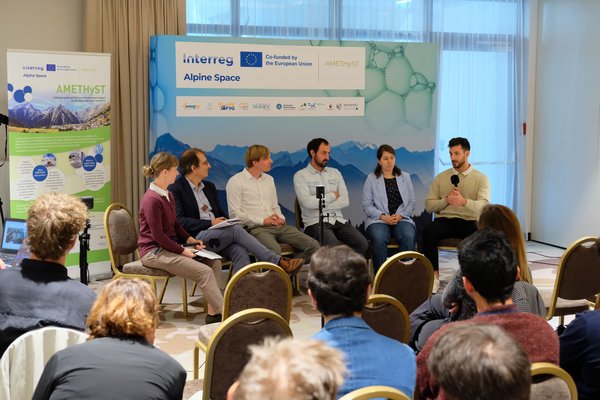2023.10.12
AURA-EE and the partners of the European project AMETHyST gathered in Innsbruck, Austria, on October 3rd and 4th to discuss the decarbonization of the Alpine region using hydrogen as an energy vector.
The participants had the opportunity to visit Europe's largest alkaline electrolyzer producing green H2. This installation supplies the ovens of a supermarket chain's bakery as well as the hydrogen trucks that replenish it: www.demo4grid.eu
AMETHyST partners also had the chance to engage in a roundtable discussion with project leaders and technicians from the Tyrol region about the necessary conditions for developing a local H2 ecosystem.
Workshop take-aways
Key observations were made regarding the challenges and opportunities in the field of hydrogen (H2) strategies. The workshop primarily focused on identifying barriers to the implementation of H2 projects, and these insights can be categorized into three main themes: stakeholder engagement, technology, and financing.

Stakeholder engagement
- Education: a notable concern emerged regarding the lack of public awareness about H2 technology among the local population. To address this issue, it was emphasized that support from local authorities and a strong political will are essential.
- Building Collaborative Networks: establishing connections between local and private stakeholders was recognized as a challenging but necessary task for the successful implementation of H2 projects.
- H2 as a solution: Participants acknowledged that H2 serves as a crucial step towards energy independence and sustainability.
Technology
- Versatile Applications: H2 can find applications in various sectors, including mobility, heating, industry, tourism, and energy storage. It is particularly valuable in situations where electrification solutions face significant challenges.
- Storage Needs: to ensure reliable H2 supply throughout the year, substantial storage space is required, particularly for managing fluctuations in demand between seasons.
- Renewable Energy: green H2 production demands a significant supply of renewable energy. The development of a reliable energy grid and access to experts is crucial for sustainable H2 production.
- Production and Usage Strategy: a coherent strategy that covers both production and utilization of H2 is vital for long-term success
- Ecosystem Scale: decisions must be made about the scale of H2 ecosystems – whether they shoulddbe local, regional, or broader. The concept of open versus closed ecosystems (import/export) must be considered in terms of efficiency.
- Timelines: clarity is needed on when and how often H2 will be used, necessitating data collection efforts.
- Visual Impact: consideration should be given to the visual aspects of H2 infrastructure, especially in terms of its integration into existing landscapes.
- Risks: risks associated with H2 usage, such as safety concerns and regulatory restrictions in some countries, require clarification.
Financing
- High Costs: H2 projects are associated with high costs, and support from local authorities is crucial to make these endeavors financially viable.
- High Risk: given the experimental state of H2 technology, courageous investors are lacking. Strategies to mitigate risks and encourage investment need to be developed.
- Price Volatility: the costs and pricing of H2 are subject to change and can be challenging to estimate accurately.
- Two Approaches: two distinct approaches to H2 infrastructure development were discussed: a) building the structure only when there is sufficient demand, and b) proactively establishing infrastructure, which can, in turn, stimulate customer demand.
These key insights shed light on the complex landscape of H2 strategies and will guide future efforts to overcome the identified barriers and promote the adoption of hydrogen technology.
About AMETHYST project
AMETHyST aims to support the deployment of local Alpine green hydrogen ecosystems to pave the way for a post-carbon lifestyle in the Alps. Read more


Imprimer